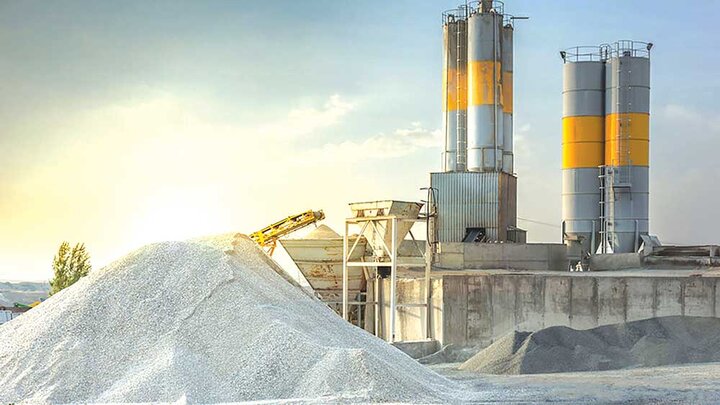
More than 180 years have passed since the mass consumption of Portland cement and now this product has become one of the most important building materials. Examining the global production and consumption of Portland cement means that cement, as an industrial product, has the highest production figure among all industrial products.
The word “cement” literally means “glue” and “cement” in construction materials is a glue that is able to stick sand particles (aggregate) due to mixing with water and does not dissolve in water even after hardening. This type of cement is called hydraulic cement and is basically composed of calcium oxide. This oxide combines with aluminum, silicon and iron oxides and creates mineral compounds or phases with cement properties.
Although mankind has been familiar with materials that have hydraulic properties and do not dissolve in water after hardening, it was about 230 years ago that scientific and systematic investigations were carried out on this type of mortar and the main factors of their cementity. Started.
At the beginning of the work, kilns similar to lime kilns were used to produce cement, and due to its great popularity, at the end of the 19th century, rotary kilns were invented, and now the technology is such that with the minimum possible energy consumption and manpower, capacity kilns 10,000 tons are supplied per day.
The main materials for the production of cement are: limestone and clay (silica and alumina), which are found in abundance in nature, but are not in a form that can be used directly in the production of cement.
What compounds does cement contain?
quicklime or calcium oxide (CaO)
Quicklime or calcium oxide is one of the main ingredients in making cement. Calcium oxide is obtained by baking limestone or calcium carbonate at a temperature of about one thousand degrees Celsius. This process is not done separately and in the cement production process and during the heating of lime and clay mixed powder, first the lime particles (calcium carbonate) are baked at a temperature of about 1000 degrees Celsius and turn into calcium oxide or quicklime. In this heat, the chemical water of the clay is also separated from it. At temperatures higher than 1000 degrees Celsius, calcium oxide (quick lime) is combined with silicon, aluminum and iron oxides and cement phases are formed.
Silica (SiO 2 )
This substance, which is found in most natural stones, is one of the main ingredients in making Portland cement. When silica is heated, changes occur in its crystal structure. In the cement kiln at about 1400 degrees Celsius, silica is combined with lime and silicate is formed. Ordinary clay contains large amounts of silica. The amount of silica required is 17 to 26% of the weight of cement, and if these amounts cannot be provided using ordinary clay, it can be provided using other sources.
Alumina (Al 2 O 3 )
Alumina, or pure aluminum oxide, is present in large quantities in clay. Alumina in cement making has the effect of auxiliary melting and during cement baking, it reduces the baking temperature of raw materials. In terms of cement chemistry, due to the heat inside the rotary kiln, it combines with lime and forms three calcium aluminates. The presence of this compound oxide inside the produced cement causes the cement to set faster and generate more heat when mixing cement with water. Cement mortar that contains tricalcium aluminate oxide less than 5% is resistant to sea water and other sulfated waters and does not degrade.
Iron oxide (Fe 2 O 3 )
Like alumina, ferric oxide plays the role of melting aid in cement making and reduces the firing temperature of raw materials inside the furnace. This oxide is combined with lime in the furnace and during baking, forming the four-calcium aluminofrite compound oxide. Iron oxide is the main constituent of most iron ores; Therefore, ferric oxide is more or less present in most clay minerals, and in most raw materials for making cement. In manufactured Portland cement, its compound oxide is formed, which darkens the color of the cement. It should be noted that white cement does not contain iron oxide.
Labels: Order to build a Forex robot , Build a stock trading robot , Build a trading robot , Trader robot design , Free Forex Robot , Forex robot programming , Forex Expert Making Tutorial , Build a trading robot with Python , Download Forex Trading Robot , Buy Forex Trader Robot , Automated Forex Robot , Free stock trading robot , Learn how to build a Forex trading robot , Alpari trading robot , Forex robot for Android , MetaTrader robot design , MetaTrader robot programming , Forex robot design , Forex robot programming , Automated trading
magnesium oxide (MgO)
This oxide plays the role of melting aid in the baking process and should not be more than a certain amount (5%) because it does not combine with other cement compounds and does not enter the cement phases and remains free in the cement. Considering that MgO combines with water very slowly after taking cement mortar and leads to volumetric expansion. As a result, hairline cracks are created in cement mortar and concrete, which causes their destruction over time. Therefore, magnesium oxide should not be more than 5% by weight in cement.
◊ Be sure to read this article: fundamental analysis training
Alkalis
Sodium and potassium play a softening role in the cement production process and their amount should not be more than 1% of its weight. The amount of chlorine in all cements should be less than 0.1% by weight due to its destructive role in concrete. The acceptable amount of sulfuric anhydride in Portland, Robar, and Pozzolanic cements depends on their specific surface area. If their specific surface area is between 2000 and 4000 square centimeters per gram, it is 3.5 percent by weight of cement and if the specific surface area of cement exceeds 4000 square centimeters, it is 4 percent by weight of cement. It should be noted that iron ore is added to raw materials as a smelting aid.
How many stages does the cement production process include?
First step – raw materials
Alkaline substances
- iron
- aluminium
- silicon
Calcareous material
- Calcium
Based on the technology available at the cement production site, a combination of these raw materials is brought to the production unit.
Second stage – grinding of raw materials
At this stage, the raw materials entering the production unit are placed in the primary mill or combined.
The third stage – storage of raw materials
After grinding the raw materials and mixing them together, these materials are placed in the raw material storage unit to be transferred to the next stage.
Step four – production of clinker
At this stage, the ground raw materials are heated in the furnace (at a temperature of 1500 degrees) (primary heating) and after heating, they are transferred to the rotary furnace. The output of the rotary thermal furnace unit is clinker or the raw material of cement production.
Step five – cement production
The clinker produced in the previous stage and stored in the clinker silo is transferred to the cement mill and gypsum and other compounds are added to the clinker. The output of this unit is the final cement.
Step Six (Final) – Save and Send
The produced cement is now transferred to cement storage silos and stored in this unit.








Comments (0)